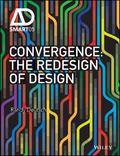Convergence
The Redesign of Design
AD Smart

1. Edition May 2017
240 Pages, Hardcover
Practical Approach Book
"There is today a pronounced and accelerated convergence in architecture. This convergence is occurring by doers not thinkers; in practice not academia; in building design, fabrication, and construction. It is about solution-centric individuals engaged in real time problem solving, not in abstractions. The nature of this convergence, where things are converging and what that means for architecture, is the subject of this book."
--from the Introduction
Those working in architecture and engineering feel pressure to work faster, at lower cost, while maintaining a high level of innovation and quality. At the same time, emergent tools and processes make this possible. Convergence is about the firms, teams and people who thrive in this environment as a result of their ability to creatively combine and innovate. It seeks to answer several timely questions: What are the tools and work processes that are converging? How are individuals and organizations converging their tools and work processes? What challenges and benefits are they seeing? What is the ultimate endgame of this convergence? What skillsets and mindsets would someone need to develop to work effectively in this changing environment? What are the implications of convergence on the role of the designer, and on design? On how we design, build, fabricate, and construct? On how we work?
The book explains how convergence relates to, but ultimately differs from integration, consolidation, multi-tasking, automation, and other forms of optimization. The practice-based research builds upon the author's research in BIM and in the collaborative leveraging of data in design and fabrication. As an investigation and meditation on the impact of technology on the education and making of design professionals Convergence explains what is happening in the world of design, and discusses the implications for the future of education, training and practice.
INTRODUCTION: DESIGN IN A TIME OF SIMULTANEITY, SUPERINTEGRATION, AND CONVERGENCE 8-19
Convergence Defined 8
Convergence Paradigms 13
Convergence Questions 18
CHAPTER 1 10 FACTORS LEADING TOWARD CONVERGENCE 20-39
Convergence and Integration 21
Convergence and Consolidation 21
Convergence and Automation 22
Convergence and Efficiency 23
Convergence Triggers 25
10 Factors Bringing About Convergence 25
Challenges to Convergence 36
CHAPTER 2 DATA AND INTUITION 40-63
A Look Back at the Data 41
Quantitative vs. Qualitative Data 47
Architecture Starts with Intuition 49
The Limits of Data in Architecture 51
The Convergence of Everything 53
What Convergence Works Against 55
Data and Intuition in Design Tools 60
CHAPTER 3 ANALYTICS AND MODELS 64-91
Integrated Analytics 64
Modeling and Simulation 71
Energy Modeling 72
Compliance Modeling 74
Geodesign, GIS, and BIM 77
Does Technology Facilitate Convergence? 79
Data, Accessibility, and Convergence 85
The Point Where All of the Intelligence Converges 85
CHAPTER 4 PARAMETRICS AND COMPUTATION 92-117
BIM Tools 93
Challenges to the Convergence 98
Computational Tools 99
On the Evolution of a Parametric/Computational Convergence 103
Simulation and Automation 107
The Algorithm of Everything 109
Algorithms and Machine Learning 112
CHAPTER 5 VIRTUAL AND PHYSICAL 118-141
Advances in Virtual Reality 119
VR and Reality Capture 121
Reality Computing 125
Uses for VR in Architecture 125
VR and AR in Architecture, Engineering, and Construction 126
Leveraging Video Games in AEC 129
Implementing Encapsulated Knowledge 130
BIM and Gaming 132
Artificial Intelligence, Machine Learning, and
Machine Vision for BIM 133
Nature Abhors a Convergence 134
CHAPTER 6 CONCEPTION AND CONSTRUCTION 142-165
"When Does Design End and Construction Begin?" 143
Buildings as Documents 153
Fusing the Computational and Material 154
Convergence of Technology and Construction 154
CHAPTER 7 DESIGN AND FABRICATION 166-191
Your Next Building Will Be Manufactured 167
Reasons for a Design/Fabrication Convergence 168
Drones and Robots 169
Cross-Discipline Knowledge of Engineering, Architecture, Computer Science, and Management 173
Toward an Architecture of Everything 177
CHAPTER 8 PRACTICAL AND INEFFABLE 192-215
Ideation Is Almost Antithetical to Automation 192
Between Firmness, Commodity, and Delight 195
Start with Utter Practicality 211
EPILOGUE: AN IMPENDING PERIOD OF INTENSE CHANGE THE SOFTWARE OF EVERYTHING 216-225
INDEX 226-232


